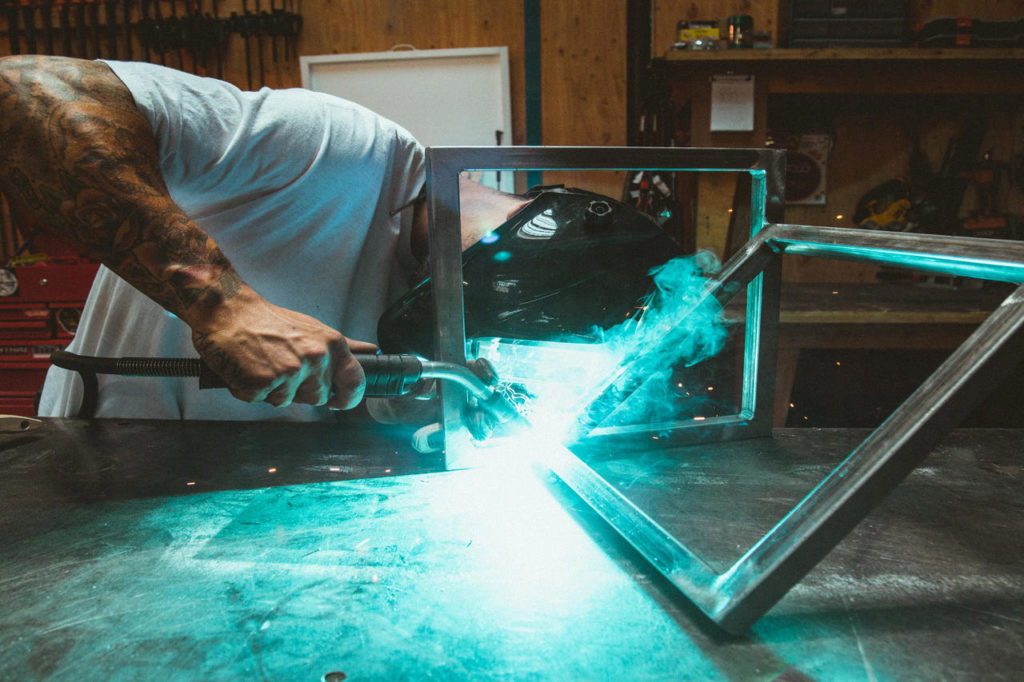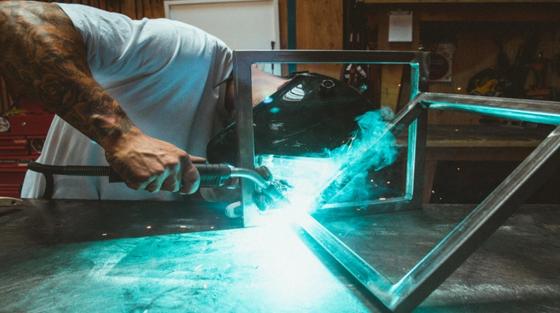
Sheet metal fabrication is the process of forming a metal sheet into a desired shape. This is a popular manufacturing process that uses metal sheets for creation of a product. The process is widely used in the metal manufacturing industry.
There are a few steps involved in converting a metal sheet into the product. These steps involve cutting and bending of the sheet metal to achieve the desired shape, surface treatment, and assembling the sheets to make the final product.
Sheet Metal Fabrication Process

There are different methods of fabrication that can be performed on sheet metal to obtain the desired end-result. But the fundamentals of sheet metal fabrication remain the same. The process can be broken down into the following steps:-
1. Sheet Metal Cutting
Cutting or shearing is the process of severing the sheet metal without using heat or any other form of energy. This can be done with the help of a die or shears or blades that have a higher tensile strength.
Shearing is the most common method of cutting the sheet metal and it involves placing the sheet between two blades that have a sharp edge. Then the top blade is brought down, effectively forcing the sheet onto the bottom edge, which essentially cuts the sheet from both the upper and lower edge.
Another method that is widely popular is using a punch die. In this method, a die is placed on the surface of the sheet metal and is punched down, effectively making a hole on the surface of the shape of the die used.
Water jet cutting is also a method that is becoming very common these days. In this method a stream of high pressure water is used to cut the sheet. This leaves a very clean cut with high dimensional accuracy.
Laser cutting is another popular method used for cutting sheet metals. Laser cutting uses a high power laser which is guided with the help of computer numerical control (CNC) to direct the energized laser beam onto the metal surface. The process leaves a highly accurate and clean cut, with the highest degree of precision.
2. Sheet Metal Bending
After getting the sheet metal cut to the desired shape and size, the next process is to bend the sheet to form the shape.
There are a few ways for accomplishing this but the most common methods are using a metal brake or form bending the sheet using a hammer.
In a metal brake, one end of the sheet is placed inside an opening, also known as a gate, and the other end is pressed with a bar. The pressing produces the required bends on the part of the sheet which is inside the gate.
The form bending process involves bending the sheet using a hammer. In this method the sheet is placed over an edge and it is struck by the hammer. Due to repeated blows, the sheet bends along the edge.
3. Sheet Metal Welding
Welding is a crucial part of sheet metal fabrication. Metal sheets are welded together to form the product and thus to form a good joint between sheets, proper welding is really important.
There are several methods of welding that are used in the industries. These depend upon the material type, the type of joint you want, the thickness parameter of the sheets and so on.
The most common type of welding method used is MIG welding. In this process an arc is created between the metal surface and a solid electrode wire, fed through the weld gun.
This arc melts both the metals and a weld pool consisting of both the metal sheet and the electrode is formed. Thus the electrode acts as the filler material for the welding joint.
Other methods such as TIG welding and laser welding are also used but they are not as versatile as the MIG welding process.

4. Sheet Metal Shrinking
This process is carried out on sheet metals to get rid of dents and other such surface deformations or to get a smooth surface after bending the sheet.
At times dents might get formed on the surface of the metal sheet and the smoothness of the surface gets compromised. Heat shrinking methods are used to treat such deformations.
There are many shrinking methods that can be used. Heat shrinking using a torch is one such method in which surface deformity is treated with a torch.
The heat from the torch causes the metal surface to stretch and the surface shrinks on cooling. This improves the smoothness of the surface.
Shrinker machines are becoming very popular and are being used more often in the industry. This machine is used to automate the entire shrinking process by using mechanical force to shrink the metal sheets to desired shape.
5. Sheet Metal Stretching
Stretching is another process of changing the shape of the sheet metal. It is the opposite of the shrinking process, as in the stretching process the metal sheet is stretched and the surface of the sheet changes accordingly.
Stretch forming can be accomplished in several ways but the most effective method is by using a Stretch Press machine. The sheet metal is securely gripped on both sides by gripping jaws. The jaws then apply pulling force on the sheet to stretch it.
The jaws are powered by pneumatic or hydraulic pistons and depending on the amount of stretch desired, the power is applied to the jaws. This stretches the sheet metal accordingly. Sometimes dies are also used to bend the sheet along with the stretching process.
The English wheel is also a machine used for sheet metal stretching. This is similar to die pressing, as the sheet is placed on the edge of an anvil and is stretched by pressing on the sheet with the wheel. Thus the sheet stretches along the surface of the anvil.
6. Sheet Metal Finishing
Finishing is done at the end of the metal fabrication process. This process is done to preserve the metal from elemental effects such as corrosion. If proper finishing is done on the metal product, the metal will last longer and will also remain in better condition.
There are many finishing techniques and depending on the type of material, selecting a proper technique is very important.
One common technique used in the industry is sandblasting. In this technique the sand and other abrasive particles are propelled at high pressure on the metal surface.
This produces the desired changes on the metal surface, such as smoothening, sharpening or cleaning of the hard metal surface.
This technique is also known as abrasive blasting, as different abrasive materials are used depending on the effect desired.
Apart from this, polishing, metal coating and buff polishing are also some of the finishing techniques that are widely used in the industry.
Sheet Metal Assembly
After the fabrication has been completed on sheet metal, the next step is actually making the product by assembling the various components.
Sheet metal assembly consists of joining the metal pieces together. This can be accomplished in many ways and depending on the design, selecting the correct method of assembly is very important.
The method of assembly may also differ with the type of metal, as different processes can be used on different types of metals. Some of the common methods that are widely used are:
1. Welding
Welding is by far one of the most common methods of joining sheets together. Welding creates a strong bond between the two sheets but the material being used for making the weld should be proper.
This method includes melting the sheet material at the joint of the weld with the filler material of the weld. This metal pool hardens and creates the bond between the sheets.
The joint may become weak if proper weld material is not used or the actual welding is not done properly. But this is the most common method and is a comparatively simpler process.

2. Riveting
Riveting is another widely used method of joining sheets together. Two sheets are joined together with the help of a rivet which is placed in the rivet holes punched or drilled into the sheets.
The rivet head is held securely using a rivet mandrel. The mandrel is pulled upwards and it tightly secures the two metal sheets along the rivet head. This process can be done using a riveting gun or a riveting machine.
There are many types of rivets that can be used. Some common types are solid rivet heads, drive rivets, flush type rivets, and semi-tubular rivets.

3. Fasteners or screw joints
This method is also commonly used to join sheets together. Screws or fasteners can be directly fastened between the two sheets to hold them securely.
Tapping screws are also used for fastening sheets. Holes are tapped or drilled on the surface of the sheets. Screws are fastened through the holes and held securely.
This method is usually employed if the sheets are to be disassembled later. The joint can be loosened by removing the screws and thus the two sheets can be disassembled.
4. Clinching of sheets
This method is used when the sheets have to be joined and never disassembled. In this method both sheets are mutually clinched or pinched. This creates deformation on both the sheets and the portion of the sheet gets rigidly clamped in the deformation.
The sheets are securely held together by the mutual clamping and thus a mold is required for creating the clamp.
Applications of Sheet Metals
Sheet metal is widely used in many manufacturing industries. Different types of sheet metals are used for different processes, making it one of the most versatile manufacturing materials.
Some of the most common applications are building the bodywork of automobiles, building roofs, fuselages of airplanes, airplane wings and other bodyworks.
Automobile manufacturing industries, rail carriage manufacturing industries, construction industries, aircraft industries heavily depend on sheet metals for creation of products.
Depending on the type of sheet and the thickness, the application of sheet metal varies. Stainless steel has excellent corrosion resistance. Hence stainless steel sheets are used to make products that can withstand such corrosive environments. Kitchen utensils, sinks, surgical instruments are some of the products made using stainless steel sheets.

Aluminum sheets are by far the most widely used sheet metals. Aluminum is cheap, has good corrosion resistant properties, has high tensile strength and is lightweight. This makes aluminum the most ideal material for applications in automobile manufacturing industries, consumer electronic manufacturing industries, aerospace industries etc.
Unsuitability of Sheet Metal for Certain Types of Products
The fabrication process is very dependent on the geometry of the product. Thus, making products with complex geometry using sheet metal is not possible. For such applications, other manufacturing processes such as 3D printing using resins can be employed.

Sheet metals cannot be used for making highly complicated custom designs, as their viscosity affects the flexibility.
Products with smaller sizes can be more efficiently made using super-plastics or resins, while also keeping the cost to a minimum.
Thus the complexity of the geometry, size, tolerance, are some of the factors that must be taken into account while deciding the right method of manufacturing a product.
Sheet metal is an incredible material. With good tensile strength, excellent corrosion resistive properties, easy manufacturing processes, lightweight and cheap availability, sheet metal is one of the most versatile materials.










